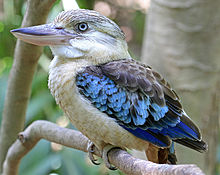Hood reads
| Hood reads | ||||||||||
|---|---|---|---|---|---|---|---|---|---|---|

Hooded lily ( Dacelo leachii ), Queensland, Australia |
||||||||||
| Systematics | ||||||||||
|
||||||||||
| Scientific name | ||||||||||
| Dacelo leachii | ||||||||||
| Vigors & Horsfield , 1826 |

The hooded leek ( Dacelo leachii ) or blue-winged kookaburra is a kingfisher species that occurs in northern Australia and New Guinea. Several subspecies are distinguished.
The IUCN assesses the inventory situation of the Haubenleist as safe ( least concern ).
features
The head of the hood read, up to 42 cm long and weighing 310 g, is colored off-white with brown speckles. The shoulders are sky blue, the torso uniform blue, the throat white, the underside white with orange-brown dots and the back brown. The beak is dark on top and yellowish on the underside. The male's tail is dark blue while that of the female is striped red-brown or blackish. Otherwise the sexes look similar.
The bird differs from the well-known laughing Hans in its light eyes, the lack of dark eye stripes and the larger proportion of blue feathers.
Occurrence
The distribution area of the Haubenliest extends over southern New Guinea and the humid areas of northern Australia from southern Queensland via Top End to western Australia in the Shark Bay area. It lives in open woodlands, on rivers with trees, in mangroves and parks.
The distribution area of the Haubenleist partially overlaps that of the Jägerliests . Basically, the hood bar stays in more humid regions than this. It occurs more frequently in gallery forests , mangrove forests and along rivers than its sister species, which prefers drier and more open terrain.
behavior
In the wet season the food consists of insects , reptiles and frogs , in other months it consists of fish , crabs , scorpions , spiders , snails , worms , small birds and mammals . The shy bird often sits quietly in the foliage and is therefore often overlooked.
Reproduction
The Haubenliest breeds mainly in natural tree hollows up to 25 m high, sometimes also in termite structures or in self-made hollows in the soft wood of baobab trees . The breeding pair incubate mostly three eggs for 26 days. The nestling period lasts around five weeks. Young birds from previous years help raise the young. When food is scarce, a chick may kill its siblings.
Systematics
A specimen copy of the hood reading was already collected by Sir Joseph Banks in 1770. However, the similarity with the Jägerliest ensured that it was initially not recognized as an independent species. It was first scientifically described in 1826 by Nicholas Aylward Vigors and Thomas Horsfield .
The Haubenleist is one of four types of the hunter's lair , all of which are found in Australia, Tasmania and New Guinea. They are also occasionally referred to in German as Kookaburra , a name that is derived from one of the languages of the Australian Aborigines .
The number of subspecies of the Haubenleist is controversial. As a rule, however, four subspecies are listed.
- D. leachii leachii is the nominate form and occurs in Australia from Brisbane to Broome .
- D. leachii cervina is a subspecies found on Melville Island in northern Australia and the adjacent mainland.
- D. leachii cliftoni is a subspecies found in northwestern Australia
- D. leachii intermedia is limited in its distribution to New Guinea.
Dedication names
The species was named in honor of the British zoologist William Elford Leach . Accordingly, it bears the specific epithet leachi .
literature
- C. Hilary Fry , Kathie Fry, Alan Harris: Kingfishers, Bee-Eaters, & Rollers. Princeton, New Jersey 1992, 1999, ISBN 0-691-04879-7 .
- Sarah Legge: Kookaburra: King of the Bush . CSIRO Publishing, Collingwood, Victoria 2004, ISBN 0-643-09063-0 .
- Ronald Strahan: Cuckoos, Nightbirds & Kingfishers of Australia . Angus & Robertson, Sydney 1994, ISBN 0-207-18522-0 .
Web links
- Videos, photos and sound recordings of Dacelo leachii in the Internet Bird Collection
- Australian website
- Dacelo leachii inthe IUCN Red List of Threatened Species 2016.1. Posted by: BirdLife International, 2016. Retrieved December 17, 2016.
Single receipts
- ↑ Dacelo leachii in the IUCN Red List of Threatened Species 2016.1. Posted by: BirdLife International, 2016. Retrieved December 17, 2016.
- ^ Strahan: Cuckoos, Nightbirds & Kingfishers of Australia . P. 140.
- ↑ Legge, Kookaburra: King of the Bush , pp. 16-17
- ↑ Legge, Kookaburra: King of the Bush , p. 22
- ↑ Bo Beolens, Michael Watkins: Whose Bird? Men and Women Commemorated in the Common Names of Birds . Christopher Helm, London 2003, p. 205.

